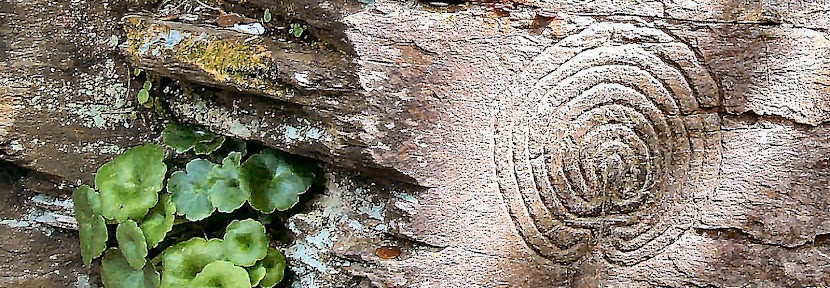Saints, Demons and Conjurors
Ladock Folklore by Alex Langstone
The village
of Ladock lies in the heart of the mid-Cornwall countryside a few miles to the
north-east of the city of Truro. The settlement is named after Lodoca, a 6th
Century Irish Abbess, who, like so many of her contemporaries, came to Cornwall
to set up a religious community. She is thought to have founded her settlement
close to the holy well, at Fentonladock. There is an old story associated with
her and her neighbouring missionaries, Grace and Probus. One day they all
decided that the boundary between their two villages should be formally marked.
They would each rise at dawn, and walk towards their neighbour’s settlement,
and where they met would be the new boundary. Probus set off at dawn, but
Ladoca decided to brush her very long hair before she set off. By the time she
had finished, Probus had almost arrived at Lodoca’s settlement, hence the
current parish boundaries uneven size.
Ladock
Glebe holy well (pictured left) on the valley floor below the church, is where water has
traditionally been collected for baptisms, and this beautiful holy well sits in
an enchanting green dell amid oak, holly and beech trees, with the church tower
clearly visible on the hill to the south.
The village is also home to the
amazing tales of Parson Wood, Ghost layer extraordinaire. William Wood was
rector at Ladock between 1704 and 1749, a time when many Cornish clergy were
involved in lavish exorcisms of demons and ghosts. Rev. Wood was a skilled
exorcist, astrologer and occultist and he was kept busy keeping many
undesirable entities at bay. He was respected by all his parishioners and was
at the heart of village life, being actively involved in the continued survival
of traditional Cornish wrestling and hurling. He was the official keeper of the
silver hurling ball, and encouraged the game in the parish. When out, the
Parson would carry a fancy ebony walking stick. It had a massive silver finial
on which was engraved a pentacle, and just below this, on the dark shaft of the
stick was a band of silver, engraved with planetary symbols and mystical
figures.
 |
| Parson William Wood's walking stick by Paul Atlas-Saunders. Copyright 2017. |
He is famous for laying many ghosts and devils, and he was usually a
match for most demons, whom he would change into animals and dispatch with his
whip. However, one of his most famous exorcisms proved to be more problematic. This
particular demon took the shape of a terrifying bird like figure that took the
church tower as his home. The demon was very large with coal-black plumage and
fiery eyes. The feathered fiend, which looked like no known bird, would make a
hideous racket, which would bellow down the tower, petrifying the bell-ringers.
The Parson was having trouble laying the demon by his usual methods, as he kept
hiding behind the pinnacles on the tower, and Wood eventually devised a plan of
exorcism using newly baptised children to rid the village of this noisy menace.
He gathered nine unbaptised children to the church. Once baptised, the children
were presented around the base of the tower along with mothers, who each held
their children aloft, whilst Parson Wood walked around them all, muttering and
cutting the air in various figures with his walking stick. The fiend eventually
took flight, after one last prolonged screech, and he darted straight up flapping
his dark and demonic wings, from which fiery sparks and flames of blue were
seen billowing, as the demon headed for St Enoder. The
Parson was also famous for foiling an attempt by the Devil to beat local
Cornish wrestling hero John ‘Jackey’ Trevail at a clandestine midnight
wrestling match on Le Pens Plat Common, and it was rumoured that the devil in
question may have been sent by the neighbouring St Enoder witches, who could
often be seen flying on their ragwort stems during the time of the full moon or
heading home after their midnight meetings in the shape of hares.
There is mention of a “celebrated
Ladock conjuror”, in Richard Polwhele’s Traditions
and Recollections volume 2, 1826. This particular conjuror is reported to
have found a man who had fallen into a shaft of Creekbraw’s Mine, using some
sort of remote viewing, and was able to recover stolen money by occult means. Was
this conjuror Parson Wood? Maybe, but Polwhele seems to hint that it was a
different person, with the following passage –
“In the last age, some
of the rusticated clergy used to favour the popular superstition, by pretending
to the power of laying ghosts… I could mention the names of several persons
whose influence over their flock was solely attributable to this circumstance.
By far other means, we now endeavour to secure the good opinion of those who
are committed to our care”
So, who was
this mysterious “celebrated Ladock conjuror”? I doubt we will ever know for
sure, and it is probable that Parson William Wood himself was the source for
these anonymous enigmatic tales.
References
Traditions and Recollections volume 2 by Richard Polwhele (1826)
References
Traditions and Recollections volume 2 by Richard Polwhele (1826)


